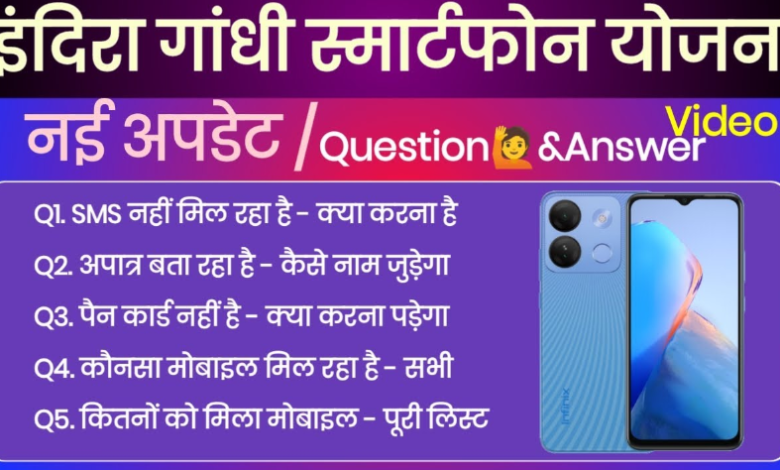Indira Gandhi Smartphone Yojana: Empowering Connectivity!

The Indira Gandhi Smartphone Yojana is a scheme launched by the state government to provide free smartphones to women in Rajasthan. It targets digital empowerment and connectivity.
The Rajasthan government introduced the Indira Gandhi Smartphone Yojana to bridge the digital divide and empower women by offering free smartphones. This initiative aligns with the global push towards embracing technology and ensuring that the benefits of digital communication are accessible to all.
Women, especially from rural areas, stand to gain significantly as smartphones can open doors to services like online education, healthcare information, and digital marketplaces. This scheme also aims to enhance women’s safety through accessible emergency communication options. The free smartphone distribution under this Yojana facilitates better network access and supports government efforts to increase digital literacy among women, thereby contributing to their socioeconomic development. The Indira Gandhi Smartphone Yojana is a pivotal move towards fostering gender equality in the digital space and fueling progress in Rajasthan.
Contents
- 1 Indira Gandhi Smartphone Yojana: Bridging The Digital Divide
- 2 Historical Context: India’s Leap Into The Digital Era
- 3 Yojana’s Key Features: What You Need To Know
- 4 Impact On Education: Learning In The Age Of Information
- 5 Women Empowerment: Connectivity As A Tool For Freedom
- 6 Economic Implications: Stimulating Micro-entrepreneurship
- 7 Barriers And Challenges: The Road To Inclusive Connectivity
- 8 Policy Analysis: Examining Governmental Frameworks And Support
- 9 Looking Forward: The Future Of Government-provided Technology
- 10 Stories From The Ground: Beneficiaries Share Their Experiences
- 11 Conclusion
Indira Gandhi Smartphone Yojana: Bridging The Digital Divide
The Indira Gandhi Smartphone Yojana marks a significant leap forward in narrowing the digital gap in India. This initiative promises to connect the unconnected, bringing many opportunities to the palms of millions. It is a transformative step towards creating a digitally inclusive society where information is power, and that power is made accessible to all.
Aim To Enhance Digital Inclusion
The core mission of the Yojana is straightforward yet impactful: provide smartphones to empower the underserved populace. Smartphones are portals to essential services such as education, healthcare, and banking. With this program, digital inclusion becomes a tangible reality for many, ushering in economic growth and improved quality of life.
- Access to government services
- Improvements in learning outreach
- Facilitation of digital payments and transactions
Target Demographics: Focusing On Empowerment
Targeting demographics is crucial to the Yojana’s success. This program primarily benefits women and the youth, two groups pivotal to the nation’s progress. Women gain independence through digital literacy, and the youth secure a bridge to the wealth of knowledge online. The program charts a path for everyone to realize their potential in a digitally equipped India.
| Group | Benefits |
| Women | Economic empowerment, safety, and education |
| Youth | Employment opportunities, skill development |
Historical Context: India’s Leap Into The Digital Era
India has been on a remarkable digital journey. This journey is changing millions of lives. It brings technology to people’s hands. The Indira Gandhi Smartphone Yojana is one step further. It highlights India’s leap into the digital era.
The Evolution Of Digital Initiatives In India
India’s digital initiatives have a unique timeline. Here is a brief overview:
- 2009: The Aadhaar project begins. It creates unique IDs for Indian residents.
- 2015: Digital India campaign launches. It aims to empower society with technology.
- 2016: Unified Payments Interface (UPI) rolls out. This makes money transactions easy.
- 2020: India enters the 5G race. It starts to test and prepare.
- 2021: The PM-WANI scheme launches. Now, public Wi-Fi access has increased.
Indira Gandhi’s Legacy And Technological Progress
Indira Gandhi’s era left a strong impact. Her commitment to progress lives on. Here’s how:
| Years | Impact |
| 1966-1977, 1980-1984 | She supported science and technology. Her policies pushed India’s tech frontiers. |
| 2023 | The Yojana, named after her, aims to give smartphones to women. It connects them to the digital world. |
Under her leadership, India embraced new tech dreams. These dreams shape today’s digital India. The smartphone plan is a tribute to her vision.
Yojana’s Key Features: What You Need To Know
Understanding the Indira Gandhi Smartphone Yojana is essential. This scheme is a big step. It helps women. The Yojana has features that make a difference. Let’s explore these exciting features together.
Eligibility Criteria And Enrollment Process
To benefit from the scheme, certain conditions must be met. The Yojana targets specific groups.
- Residence: The participant must be a resident of the area covered by the Yojana.
- Income: Income limits are set to ensure fairness.
- Gender: Focused on empowering women, so gender eligibility is critical.
The enrollment process is straightforward. Follow these steps:
- Complete the application form online.
- Submit the required documents for verification.
- Wait for confirmation of acceptance.
Smartphone Specifications And Distribution Method
The smartphones offered are modern. They meet today’s technological needs. Here are the basic specs:
| Feature | Specification |
| Screen Size | 5 inches or more |
| Battery | Long-lasting |
| OS | Latest Android |
| Camera | High-resolution for clear photos |
The distribution method is designed for ease. Devices get to recipients quickly. A few points on distribution:
- Local government units play a role in handling devices.
- Beneficiaries receive notifications on where and when to collect.
- Verification occurs at the point of collection to ensure security.
Impact On Education: Learning In The Age Of Information
The advent of the Indira Gandhi Smartphone Yojana heralds a new era in Indian education. This initiative ensures that the power of learning and information is in the hands of many. More than ever, smartphones act as gateways to a world filled with knowledge and opportunity.
Enhancing Access To Educational Resources
The scheme breaks down barriers to education by providing smartphones. Students now have vast resources at their fingertips. They can access:
- E-books and online libraries
- Instructional videos
- Educational apps and games
- Instant study group communications
Such tools are transformative. They encourage self-paced learning and enhance understanding.
Impact On Remote Learning And Literacy Rates
In rural or remote areas, the Yojana is especially significant. Access to quality education is now close. Smartphones bring classrooms to students’ homes. This leads to:
- Rise in enrollment numbers
- Improvement in literacy rates
- Better educational outcomes
| Before Yojana | After Yojana |
| Limited access to books | Unlimited e-books |
| No remote learning | Classes from anywhere |
| Lower literacy rates | Improving literacy |
The impact on education is evident. The Yojana is a stepping stone towards a brighter and more learned society.
Women Empowerment: Connectivity As A Tool For Freedom
Empowerment echoes loudly when women in all spheres gain access to the world through technology. The Indira Gandhi Smartphone Yojana aims to launch a new era of freedom. This program promises to bring the digital revolution to women’s fingertips.
Safety, Communication, And Independence For Women
Smartphones act as safety shields
Success Stories: Women Who Changed Their Lives
- Riya, an artisan, now sells globally.
- Asha, a homemaker, started an online business.
- Priya, a student, scored at the top in her exams.
Economic Implications: Stimulating Micro-entrepreneurship
The ‘Economic Implications: Stimulating Micro-Entrepreneurship’ section of India’s Indira Gandhi Smartphone Yojana opens a fertile ground for discussion. This initiative is not just about providing smartphones. It lights a spark in the economy by enabling micro-entrepreneurs. Let’s delve into how mobile technology acts as a catalyst for small businesses and explore transformative case studies.
Mobile Technology As A Catalyst For Small Businesses
Mobile devices have revolutionized business operations across India. They serve as a lifeline for micro-entrepreneurs. Equipped with smartphones through schemes like the Indira Gandhi Smartphone Yojana, these small business owners optimize operations, reach new markets, and connect with customers instantly.
- Improved Communication: Smartphones allow instant customer interaction.
- Market Expansion: Online platforms become accessible for product showcasing.
- Efficiency Boost: Business apps help manage tasks and finances efficiently.
Case Studies Of Economic Transformation
Real-world stories best demonstrate the Yojana’s impact. Here are some examples:
- A potter from Rajasthan began marketing her wares online, quadrupling sales.
- A tailor from Assam accessed online patterns, improving his designs and customer base.
- An organic farmer from Kerala connected with city buyers, increasing his profit margins.
Each case shows significant growth facilitated by smartphone usage. These stories encapsulate the true essence of empowerment.
Barriers And Challenges: The Road To Inclusive Connectivity
The journey towards bridging the digital divide through initiatives like the Indira Gandhi Smartphone Yojana faces multiple obstacles. These barriers pose significant challenges. They prevent seamless connectivity from becoming a reality for all. Identifying these issues is the first step to creating solutions and ensuring inclusive connectivity.
Rural Penetration And The Infrastructure Hurdle
Rural areas often need more infrastructure for digital connectivity. This includes not only the physical hardware like cell towers but also reliable electricity and internet services. These are essential for smartphones to function effectively. Common hurdles include:
- Limited access to high-speed internet
- Unreliable power supply, affecting device charging
- Sparse network coverage, leading to connectivity issues
| Issue | Impact |
| Network Availability | Difficulties in accessing online services |
| Electricity Consistency | Challenges in keeping devices charged |
For the Yojana to succeed, infrastructure must develop much faster. It must also ensure that rural populations are included.
Overcoming Literacy And Skill Gaps
Literacy and digital skills are critical to fully utilizing smartphones. With the Indira Gandhi Smartphone Yojana, beneficiaries need the ability to operate these devices. Skill gaps are significant when it comes to:
- Understanding how to use smartphones
- Utilizing applications for services and communication
- Protecting themselves against digital fraud and scams
This calls for tailored educational programs. These programs should focus on teaching these skills in simple, approachable ways. Building a foundation of digital literacy will empower users and allow them to take full advantage of the smartphone’s potential.
Targeted training efforts can demystify technology. It will reduce the intimidation factor. Programs designed with this goal can transform users from novices to confident participants in the digital world.
Policy Analysis: Examining Governmental Frameworks And Support
Policy Analysis: Examining Governmental Frameworks and Support evaluates the pillars that sustain the Indira Gandhi Smartphone Yojana. This scheme’s success hinges on frameworks that encourage participation and efficiency. A solid understanding enables us to gauge the initiative’s viability and potential areas for enhancement.
Collaborations Between Public And Private Sectors
The Indira Gandhi Smartphone Yojana thrives on active collaboration. This partnership blends public oversight with private-sector innovation. Private companies provide technology and logistic support, while government bodies ensure fair distribution and transparency. This synergy aims to bridge the digital divide among citizens.
- Governmental Role: They set guidelines, monitor progress, and measure outcomes.
- Private Sector Role: Supply smartphones, enhance network capabilities, and provide user education.
Critique And Suggestions For Policy Enhancements
A critical examination of this policy reveals its strengths and areas for improvement. The demand for smartphones often outstrips supply, there are delivery delays, and some users need more basic digital skills. Addressing these challenges could improve the Yojana’s impact.
- Accelerate procurement and streamline distribution channels.
- Regularly update software and hardware specifications.
- Expand digital training for beneficiaries to maximize smartphone utility.
| Issue Identified | Suggested Enhancement |
| Supply Shortages | Increase supply chain efficiency |
| Delivery Delays | Optimize logistic networks |
| Skill Gaps | Implement training modules |
To ensure the policy evolves, the government should analyze feedback. They should revise the initiative to suit changing technology landscapes.
Looking Forward: The Future Of Government-provided Technology
Embracing the digital era, the Indian government’s Indira Gandhi Smartphone Yojana marks a significant leap in bridging the digital divide. With innovative schemes, the government offers technology to those in need, seeding opportunities for growth and development. Let’s unveil the road ahead for government-driven tech initiatives.
Next-generation Technologies And Their Potential Impact
The introduction of next-generation technologies holds promise for transformative change. These advancements can revolutionize daily life and empower citizens with cutting-edge tools.
- Artificial Intelligence: AI could tailor services per user needs, optimize government processes, and deliver innovative solutions.
- Blockchain: Secure data sharing across departments enhances transparency and trust in public services.
- Internet of Things (IoT): IoT devices can boost public infrastructure efficiency, leading to smarter cities.
Expanding The Yojana For Broader Reach
To amplify the benefits, the scheme aims for a broader canvas. Accessibility is critical, with plans to cater to remote regions.
The focus straddles enhancing connectivity and user engagement. Creative thinking and strategic partnerships will scale the initiative, ensuring technology serves all.
| Focus Area | Strategies |
| Urban communities | Streamline distribution networks, increase awareness campaigns |
| Rural regions | Collaborate with local bodies, utilize vernacular languages |
| Women and youth | Offer specialized training programs, support entrepreneurship |
The Indira Gandhi Smartphone Yojana brings transformative stories of individuals. These tales highlight life before and after receiving a smartphone. Beneficiaries touch upon the immediate impact and evolving benefits over time.
First-hand Accounts From The Smartphone Recipients
Vivid testimonials shed light on the empowerment achieved through this initiative. Let’s hear directly from the recipients.
- “Communication with loved ones is now easy,” says Sunita, a mother from a rural village.
- Rohan, a young job seeker, shares, “Finding work has become less of a challenge.”
- For Priya, a student, “Access to online education opened new doors.”
Long-term Effects On Daily Life And Aspirations
These devices are more than just tools; they represent hope and opportunity. Hear how they shape futures.
| Beneficiary | Long-term Change | Aspirations |
| Anil | Improved farming techniques | Become an agripreneur |
| Meena | Digital literacy skills | Start a small business |
| Nitin | Enhanced learning | Pursue higher education |
Daily tasks are now more straightforward. Dreams seem attainable.
Conclusion
The Indira Gandhi Smartphone Yojana is a transformative step in digitally connecting more citizens. It promises empowerment through technology, reflecting India’s commitment to inclusive progress. As accessibility widens, bridging the digital divide becomes a reachable goal. Let’s stay tuned for its impact on society’s tech-savviness.


